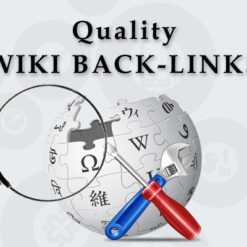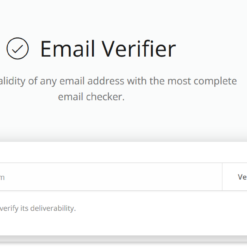-
×
 5,000 Wikipedia backlinks for your URL and keywords
₹ 999.00
5,000 Wikipedia backlinks for your URL and keywords
₹ 999.00 -
×
 2000+ Wikipedia Backlinks from 3,000 Wiki Articles
₹ 999.00
2000+ Wikipedia Backlinks from 3,000 Wiki Articles
₹ 999.00 -
×
 Buy Lead Generation services for lead generation, linkedin lead, linkedin lead generation, b2b lead generation, lead gen, real estate leads by lead generation companies
₹ 398.00
Buy Lead Generation services for lead generation, linkedin lead, linkedin lead generation, b2b lead generation, lead gen, real estate leads by lead generation companies
₹ 398.00 -
×
 Buy Bulk Email Sending Service, Buy Mass Email Sending Service, Buy 1000 Mails Sending Service, Buy bulk email, mass email, send mass, bulk email sender, mass mailing, bulk email marketing services, mass email sender, bulk mailer, bulk mailer service
₹ 499.00
Buy Bulk Email Sending Service, Buy Mass Email Sending Service, Buy 1000 Mails Sending Service, Buy bulk email, mass email, send mass, bulk email sender, mass mailing, bulk email marketing services, mass email sender, bulk mailer, bulk mailer service
₹ 499.00 -
×
 Buy SEO Keywords Research for Website
₹ 99.00
Buy SEO Keywords Research for Website
₹ 99.00 -
×
 Buy Whatsapp Marketing, Bulk Whatsapp sender, advertising on whatsapp, whatsappbulk (Only for Indians)
₹ 99.00
Buy Whatsapp Marketing, Bulk Whatsapp sender, advertising on whatsapp, whatsappbulk (Only for Indians)
₹ 99.00 -
×
 Buy "Custom Designed For You" Powerpoint, Google slides, Presentation, Powerpoint templates, Slidescarnival, Google slides templates, Powerpoint presentation, MS powerpoint, Powerpoints templates
₹ 99.00
Buy "Custom Designed For You" Powerpoint, Google slides, Presentation, Powerpoint templates, Slidescarnival, Google slides templates, Powerpoint presentation, MS powerpoint, Powerpoints templates
₹ 99.00 -
×
 Buy YouTube Watchtime Hours & Subscribers to Monetise YouTube Channel
₹ 89,997.00
Buy YouTube Watchtime Hours & Subscribers to Monetise YouTube Channel
₹ 89,997.00 -
×
 Buy Graphic Design Services for Stories, Instagram Posts (Square), Invitations (Portrait), Posters (Portrait), Phone Wallpapers, YouTube Thumbnails, Resumes, Logo, Photo Collages, FlyersCards, Presentations, Facebook Posts, Certificates, Menu, Business Cards
₹ 299.00
Buy Graphic Design Services for Stories, Instagram Posts (Square), Invitations (Portrait), Posters (Portrait), Phone Wallpapers, YouTube Thumbnails, Resumes, Logo, Photo Collages, FlyersCards, Presentations, Facebook Posts, Certificates, Menu, Business Cards
₹ 299.00 -
×
 Buy article writer service, write an article, article rewriting service (SEO Optimised & Plagiarism Free)
₹ 499.00
Buy article writer service, write an article, article rewriting service (SEO Optimised & Plagiarism Free)
₹ 499.00 -
×
 Buy Scraping Services, Scraper Jobs, Web scraping, scrape google maps, data scraping, instant data scraper, screen scraping, webscraping, website scraper, twitter scraper, linkedin scraper, scrape data from website, web scraping in r, facebook scrape, web scraping legal, scraping instagram, scrape emails
₹ 100.00
Buy Scraping Services, Scraper Jobs, Web scraping, scrape google maps, data scraping, instant data scraper, screen scraping, webscraping, website scraper, twitter scraper, linkedin scraper, scrape data from website, web scraping in r, facebook scrape, web scraping legal, scraping instagram, scrape emails
₹ 100.00 -
×
 Buy Email database, Email marketing database, B2B Email database, Gmail database, Email address database, Email list database
₹ 99.00
Buy Email database, Email marketing database, B2B Email database, Gmail database, Email address database, Email list database
₹ 99.00 -
×
 Buy Indian companies database, companies database, companies data from data company, data provider, database providers
₹ 99.00
Buy Indian companies database, companies database, companies data from data company, data provider, database providers
₹ 99.00 -
×
 Buy Social Media Wallpaper Designed Images
₹ 199.00
Buy Social Media Wallpaper Designed Images
₹ 199.00 -
×
 Buy email verifier, validate emails, verify email address, check email address, check if email is valid, validate email address, email verifier online, check email validity, free email verifier, javascript validate email, check email address validity, email list verify, email verification tool, online check email
₹ 199.00
Buy email verifier, validate emails, verify email address, check email address, check if email is valid, validate email address, email verifier online, check email validity, free email verifier, javascript validate email, check email address validity, email list verify, email verification tool, online check email
₹ 199.00 -
×
 Buy mockup, logo mockup, iphone mockup, business card mockup, moqups, poster mockup, mockup design, box mockup, instagram mockup, magazine mockup, website mockup, phone mockup, laptop mockup, 3d mockup, flyer mockup, wireframe design, sticker mockup, ipad mockup, smartmockup, smart mockup
₹ 199.00
Buy mockup, logo mockup, iphone mockup, business card mockup, moqups, poster mockup, mockup design, box mockup, instagram mockup, magazine mockup, website mockup, phone mockup, laptop mockup, 3d mockup, flyer mockup, wireframe design, sticker mockup, ipad mockup, smartmockup, smart mockup
₹ 199.00 -
×
 Buy Whiteboard animation, Whiteboard explainer video, Whiteboard video, whiteboard animation studio, whiteboard animation video, white board video, whiteboard videos maker, whiteboard presentations, creating whiteboard animation
₹ 9,999.00
Buy Whiteboard animation, Whiteboard explainer video, Whiteboard video, whiteboard animation studio, whiteboard animation video, white board video, whiteboard videos maker, whiteboard presentations, creating whiteboard animation
₹ 9,999.00 -
×
 Buy Email Newsletter, Newsletter, Newsletter Design, Newsletter Formats, Newsletter examples
₹ 100.00
Buy Email Newsletter, Newsletter, Newsletter Design, Newsletter Formats, Newsletter examples
₹ 100.00
SEO
Unlocking Ecommerce Success: The Definitive Guide to SEO Strategies for Online Stores
In this article, we will explore the essential aspects of Search Engine Optimization (SEO) for ecommerce websites. From keyword research and on-page optimization to technical SEO and link building, we will delve into the strategies and best practices that can help ecommerce businesses boost their online visibility, attract more organic traffic, and drive conversions. By implementing effective SEO techniques, ecommerce websites can increase their chances of success in the competitive digital landscape.
Introduction
SEO for Ecommerce Websites – Driving Online Success
Ecommerce has revolutionized the way people shop, and with the ever-increasing number of online stores, it’s vital for businesses to stand out from the crowd. That’s where Search Engine Optimization (SEO) comes into play. SEO is the practice of optimizing a website to rank higher in search engine results, ultimately increasing its visibility and driving targeted traffic. In this comprehensive guide, we will discuss the key strategies and techniques for optimizing ecommerce websites to achieve sustainable success.
1. Keyword Research: Laying the Foundation
H2: Understanding the Power of Keywords
Effective SEO for ecommerce websites begins with thorough keyword research. By identifying the right keywords and phrases that potential customers are using to search for products, you can align your website content to match their intent. Utilize keyword research tools to find relevant, high-volume keywords with moderate competition. Long-tail keywords can also be valuable, as they often indicate a more specific intent and higher conversion potential.
2. On-Page Optimization: Optimizing for Relevance and User Experience
H2: Crafting SEO-Friendly Product Pages
Optimizing individual product pages is crucial for ecommerce SEO success. Start by creating unique and compelling product descriptions that highlight key features and benefits. Incorporate relevant keywords naturally, ensuring the content remains informative and user-friendly. Optimize meta tags, including title tags and meta descriptions, to entice search engine users and improve click-through rates. Utilize structured data markup to provide additional context to search engines.
3. Technical SEO: Building a Solid Foundation
H2: Enhancing Website Performance and Accessibility
Technical SEO focuses on the backend aspects of your ecommerce website, ensuring it is accessible and easily crawlable by search engines. Optimize website speed, eliminate duplicate content, and fix broken links to enhance the user experience. Implement a mobile-responsive design to accommodate the growing number of mobile shoppers. Create XML sitemaps to help search engines understand the website structure and index pages effectively.
4. User Experience Optimization: Engaging and Converting Visitors
H2: Creating Seamless User Journeys
User experience (UX) plays a significant role in SEO for ecommerce websites. A seamless user journey encourages visitors to stay longer, explore more products, and complete purchases. Optimize website navigation and ensure clear calls-to-action (CTAs) on product pages. Improve site search functionality and provide relevant product recommendations to enhance user engagement. Monitor and analyze user behavior using tools like heatmaps and session recordings to identify areas for improvement.
5. Link Building: Establishing Authority and Trust
H2: Building a Strong Backlink Profile
Link building remains a critical aspect of SEO for ecommerce websites. A strong backlink profile improves domain authority and signals to search engines that your website is trustworthy and valuable. Develop a comprehensive link building strategy that focuses on acquiring high-quality backlinks from relevant and authoritative sources. Seek partnerships with influencers, collaborate on guest blogging opportunities, and actively engage in industry-specific communities to earn valuable backlinks.
Now in detail,
1. Keyword Research: Laying the Foundation
Understanding the Power of Keywords
Keyword research serves as the foundation for effective SEO for ecommerce websites. Understanding the power of keywords and how they impact search engine rankings is crucial. By identifying the right keywords and phrases that potential customers use when searching for products, businesses can align their website content to match their intent and increase their chances of ranking higher in search engine results.
To begin, it’s essential to utilize keyword research tools that provide valuable insights into search volume, keyword difficulty, and competition. These tools can help identify relevant keywords with a significant search volume, while also considering the level of competition associated with them. Balancing high-volume keywords with moderate competition is key to achieving optimal results.
Long-tail keywords are also valuable for ecommerce websites. These keywords consist of more specific phrases that often indicate a higher intent to purchase. While long-tail keywords may have lower search volumes, they tend to convert at a higher rate. Incorporating a mix of both broad and long-tail keywords into your SEO strategy can help capture a wider range of potential customers.
Additionally, it’s crucial to consider user intent when conducting keyword research. Understanding the searcher’s intent—whether they are looking for information, making a purchase, or seeking a specific solution—can help tailor your content to meet their needs effectively. By aligning your keywords with user intent, you can attract more qualified traffic to your ecommerce website.
2. On-Page Optimization: Optimizing for Relevance and User Experience
Crafting SEO-Friendly Product Pages
On-page optimization is a critical aspect of SEO for ecommerce websites. Optimizing individual product pages can significantly impact search engine rankings, relevance, and user experience. By focusing on key elements such as product descriptions, meta tags, and structured data markup, businesses can enhance their visibility and attract more organic traffic.
Crafting SEO-friendly product descriptions is essential for ecommerce websites. Each product page should have a unique and compelling description that accurately highlights the features, benefits, and unique selling points of the product. Incorporate relevant keywords naturally within the content, ensuring that it remains informative and user-friendly. Avoid keyword stuffing, as it can harm both the user experience and search engine rankings.
Optimizing meta tags, including title tags and meta descriptions, is equally important. These tags appear in search engine results and play a crucial role in attracting potential customers. Title tags should be concise, descriptive, and include relevant keywords. Meta descriptions should provide a compelling summary of the product, enticing search engine users to click through to your website. By optimizing these tags, you improve your chances of capturing user attention and increasing click-through rates.
Structured data markup, such as schema.org, can provide additional context to search engines about your products. By implementing structured data, you can enhance the display of your product pages in search engine results. Rich snippets, such as product ratings, prices, and availability, can make your listings more attractive and informative to users. This can lead to higher click-through rates and increased visibility in search engine results.
3. Technical SEO: Building a Solid Foundation
Enhancing Website Performance and Accessibility
Technical SEO focuses on the backend aspects of your ecommerce website, ensuring it is accessible and easily crawlable by search engines. By addressing technical issues and optimizing website performance, businesses can improve user experience, increase crawlability, and enhance their search engine rankings.
Website speed is a critical factor in both user experience and SEO. Slow-loading websites can frustrate visitors and lead to higher bounce rates. Optimizing page load times by compressing images, minifying code, and leveraging browser caching can significantly improve website performance. Regularly monitor and analyze website speed using tools like Google PageSpeed Insights or GTmetrix to identify areas for improvement.
Eliminating duplicate content is another important aspect of technical SEO. Ecommerce websites often face challenges related to duplicate content due to similar product descriptions or category pages. Implement canonical tags to indicate the preferred version of a page and consolidate link equity. Additionally, set up proper URL structures to avoid duplicate content issues caused by parameters or session IDs.
Fixing broken links is crucial for both user experience and search engine crawlers. Broken links can lead to a poor user experience, as visitors may encounter error pages when clicking on links. Conduct regular link audits to identify broken links and either update them or redirect them to relevant pages. This ensures that both users and search engines can navigate your website without encountering dead ends.
Mobile responsiveness is a key consideration for ecommerce websites. With the increasing number of mobile shoppers, it’s essential to provide a seamless experience across different devices. Implement a responsive design that adjusts to different screen sizes and ensures that your website is mobile-friendly. Mobile-friendly websites not only enhance user experience but also improve search engine rankings, as mobile-friendliness is a ranking factor for Google.
Creating XML sitemaps helps search engines understand the structure of your website and index pages more effectively. XML sitemaps provide a clear roadmap for search engine crawlers, ensuring that all relevant pages are discovered and included in search engine results. Regularly update and submit your XML sitemap to search engines to ensure they are aware of any changes or new additions to your website.
4. User Experience Optimization: Engaging and Converting Visitors
Creating Seamless User Journeys
User experience (UX) optimization plays a significant role in SEO for ecommerce websites. A seamless user journey encourages visitors to stay longer, explore more products, and ultimately convert into customers. By optimizing various aspects of user experience, businesses can enhance engagement, reduce bounce rates, and increase conversions.
Optimizing website navigation is crucial for providing a smooth user experience. Clear and intuitive navigation menus make it easy for visitors to find the products they’re looking for. Categorize products logically and ensure that navigation menus are consistent across all pages. Incorporate search functionality prominently, allowing users to search for specific products. Implement filters and sorting options to help users narrow down their product selections.
On individual product pages, clear and compelling calls-to-action (CTAs) are essential for guiding users towards making a purchase. Use persuasive language and design visually appealing buttons to encourage users to add products to their carts or proceed to checkout. Additionally, display trust signals, such as security badges, customer reviews, and return policies, to instill confidence in potential buyers.
Site search functionality is crucial for ecommerce websites, as it enables users to find products quickly. Implement an advanced site search feature that provides relevant and accurate results. Incorporate auto-suggestions and filters to help users refine their search queries. Monitor search data and analyze user behavior to identify common search terms and improve the overall site search experience.
Personalization and product recommendations are powerful tools for enhancing user engagement. Utilize data-driven personalization techniques to deliver tailored product recommendations based on user behavior, preferences, or past purchases. Implement related product suggestions, upselling and cross-selling techniques to encourage users to explore more products and increase their average order value.
To gain deeper insights into user behavior, consider utilizing tools such as heatmaps and session recordings. Heatmaps provide visual representations of where users click, scroll, and spend the most time on your website. Session recordings allow you to watch and analyze how users interact with your site. By identifying areas where users encounter difficulties or exhibit certain patterns, you can optimize your website accordingly and enhance the overall user experience.
5. Link Building: Establishing Authority and Trust
Building a Strong Backlink Profile
Link building remains a critical aspect of SEO for ecommerce websites. Building a strong backlink profile helps establish authority, trust, and credibility in the eyes of search engines. By acquiring high-quality backlinks from relevant and authoritative sources, businesses can improve their search engine rankings and drive more organic traffic to their website.
Developing a comprehensive link building strategy is essential. Start by identifying reputable websites within your niche that have a high domain authority. Seek opportunities to collaborate with influencers or industry experts who can create valuable content and link back to your ecommerce site. Guest blogging on relevant websites allows you to showcase your expertise and gain backlinks in return.
Participating in industry-specific communities, forums, or social media groups can also lead to valuable backlink opportunities. Engage in discussions, provide valuable insights, and share your content when appropriate. By actively participating and contributing, you can build relationships with other industry professionals who may be willing to link back to your ecommerce website.
Additionally, leveraging data-driven content, such as research studies, infographics, or case studies, can attract backlinks naturally. When you publish unique and informative content, other websites and bloggers are more likely to reference and link back to it as a valuable resource.
It’s important to note that while link building is crucial, it should be approached with caution. Focus on quality over quantity, as search engines prioritize the relevance and authority of backlinks. Avoid spammy practices such as buying links or participating in link schemes, as they can result in penalties from search engines and harm your website’s reputation.
Regularly monitor your backlink profile using tools like Google Search Console or third-party backlink analysis tools. Identify and disavow any toxic or spammy backlinks that may have been acquired unintentionally. Monitoring your backlinks allows you to stay informed about the health of your link profile and take necessary actions to maintain a strong and authoritative presence.
Conclusion
Driving Online Success with SEO for Ecommerce Websites
Implementing effective SEO strategies is crucial for ecommerce websites aiming to thrive in the competitive digital landscape. By conducting thorough keyword research, optimizing product pages, addressing technical SEO issues, enhancing user experience, and building a strong backlink profile, businesses can increase their online visibility, attract targeted organic traffic, and ultimately drive conversions.
Remember, SEO for ecommerce websites requires ongoing efforts and continuous adaptation to ever-evolving search engine algorithms and user behavior. Stay updated with the latest industry trends, monitor website analytics, and analyze user feedback to refine your SEO strategy continually.
By combining the power of SEO with a user-centric approach, ecommerce websites can establish a solid foundation for long-term success, effectively connect with their target audience, and achieve sustainable growth in the competitive online marketplace.

 2000+ Wikipedia Backlinks from 3,000 Wiki Articles
2000+ Wikipedia Backlinks from 3,000 Wiki Articles  Buy Lead Generation services for lead generation, linkedin lead, linkedin lead generation, b2b lead generation, lead gen, real estate leads by lead generation companies
Buy Lead Generation services for lead generation, linkedin lead, linkedin lead generation, b2b lead generation, lead gen, real estate leads by lead generation companies  Buy Bulk Email Sending Service, Buy Mass Email Sending Service, Buy 1000 Mails Sending Service, Buy bulk email, mass email, send mass, bulk email sender, mass mailing, bulk email marketing services, mass email sender, bulk mailer, bulk mailer service
Buy Bulk Email Sending Service, Buy Mass Email Sending Service, Buy 1000 Mails Sending Service, Buy bulk email, mass email, send mass, bulk email sender, mass mailing, bulk email marketing services, mass email sender, bulk mailer, bulk mailer service  Buy SEO Keywords Research for Website
Buy SEO Keywords Research for Website  Buy Whatsapp Marketing, Bulk Whatsapp sender, advertising on whatsapp, whatsappbulk (Only for Indians)
Buy Whatsapp Marketing, Bulk Whatsapp sender, advertising on whatsapp, whatsappbulk (Only for Indians)  Buy "Custom Designed For You" Powerpoint, Google slides, Presentation, Powerpoint templates, Slidescarnival, Google slides templates, Powerpoint presentation, MS powerpoint, Powerpoints templates
Buy "Custom Designed For You" Powerpoint, Google slides, Presentation, Powerpoint templates, Slidescarnival, Google slides templates, Powerpoint presentation, MS powerpoint, Powerpoints templates  Buy YouTube Watchtime Hours & Subscribers to Monetise YouTube Channel
Buy YouTube Watchtime Hours & Subscribers to Monetise YouTube Channel  Buy Graphic Design Services for Stories, Instagram Posts (Square), Invitations (Portrait), Posters (Portrait), Phone Wallpapers, YouTube Thumbnails, Resumes, Logo, Photo Collages, FlyersCards, Presentations, Facebook Posts, Certificates, Menu, Business Cards
Buy Graphic Design Services for Stories, Instagram Posts (Square), Invitations (Portrait), Posters (Portrait), Phone Wallpapers, YouTube Thumbnails, Resumes, Logo, Photo Collages, FlyersCards, Presentations, Facebook Posts, Certificates, Menu, Business Cards  Buy article writer service, write an article, article rewriting service (SEO Optimised & Plagiarism Free)
Buy article writer service, write an article, article rewriting service (SEO Optimised & Plagiarism Free)  Buy Scraping Services, Scraper Jobs, Web scraping, scrape google maps, data scraping, instant data scraper, screen scraping, webscraping, website scraper, twitter scraper, linkedin scraper, scrape data from website, web scraping in r, facebook scrape, web scraping legal, scraping instagram, scrape emails
Buy Scraping Services, Scraper Jobs, Web scraping, scrape google maps, data scraping, instant data scraper, screen scraping, webscraping, website scraper, twitter scraper, linkedin scraper, scrape data from website, web scraping in r, facebook scrape, web scraping legal, scraping instagram, scrape emails  Buy Email database, Email marketing database, B2B Email database, Gmail database, Email address database, Email list database
Buy Email database, Email marketing database, B2B Email database, Gmail database, Email address database, Email list database  Buy Indian companies database, companies database, companies data from data company, data provider, database providers
Buy Indian companies database, companies database, companies data from data company, data provider, database providers  Buy Social Media Wallpaper Designed Images
Buy Social Media Wallpaper Designed Images  Buy email verifier, validate emails, verify email address, check email address, check if email is valid, validate email address, email verifier online, check email validity, free email verifier, javascript validate email, check email address validity, email list verify, email verification tool, online check email
Buy email verifier, validate emails, verify email address, check email address, check if email is valid, validate email address, email verifier online, check email validity, free email verifier, javascript validate email, check email address validity, email list verify, email verification tool, online check email  Buy mockup, logo mockup, iphone mockup, business card mockup, moqups, poster mockup, mockup design, box mockup, instagram mockup, magazine mockup, website mockup, phone mockup, laptop mockup, 3d mockup, flyer mockup, wireframe design, sticker mockup, ipad mockup, smartmockup, smart mockup
Buy mockup, logo mockup, iphone mockup, business card mockup, moqups, poster mockup, mockup design, box mockup, instagram mockup, magazine mockup, website mockup, phone mockup, laptop mockup, 3d mockup, flyer mockup, wireframe design, sticker mockup, ipad mockup, smartmockup, smart mockup  Buy Whiteboard animation, Whiteboard explainer video, Whiteboard video, whiteboard animation studio, whiteboard animation video, white board video, whiteboard videos maker, whiteboard presentations, creating whiteboard animation
Buy Whiteboard animation, Whiteboard explainer video, Whiteboard video, whiteboard animation studio, whiteboard animation video, white board video, whiteboard videos maker, whiteboard presentations, creating whiteboard animation  Buy Email Newsletter, Newsletter, Newsletter Design, Newsletter Formats, Newsletter examples
Buy Email Newsletter, Newsletter, Newsletter Design, Newsletter Formats, Newsletter examples 